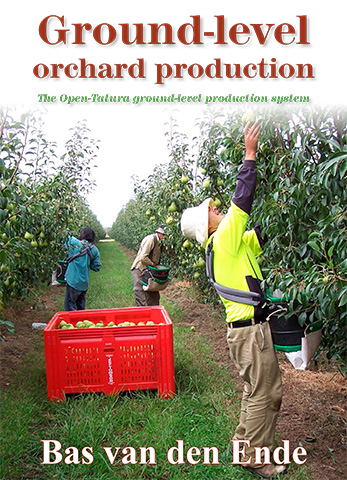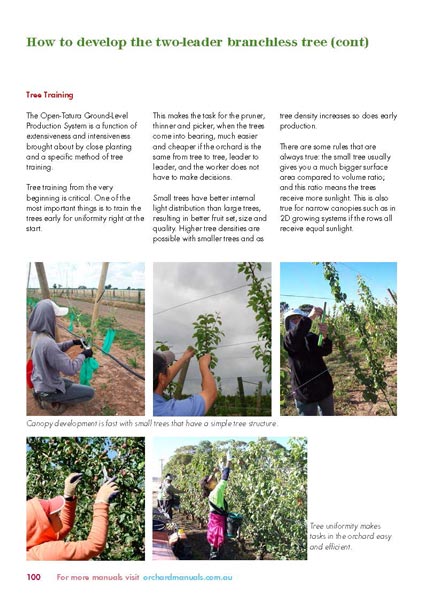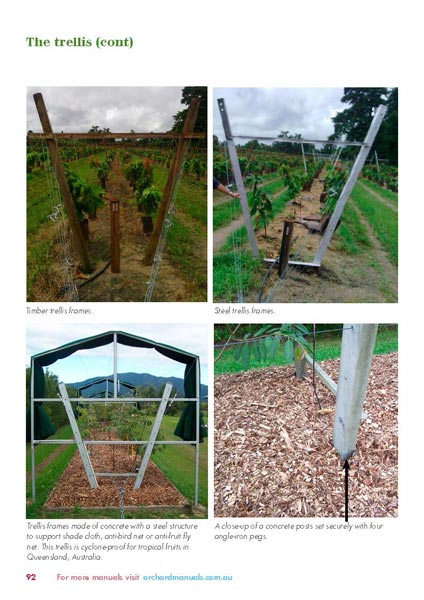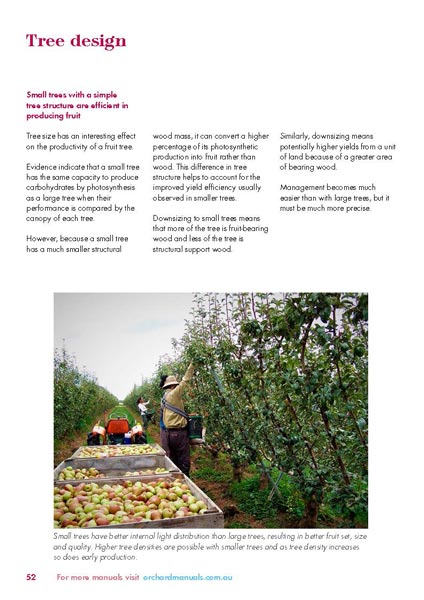
The Open-Tatura Ground-Level Production System is one of the most efficient orchard systems that can be managed from the ground.
It invites the reader to consider an affordable high density planting of fruit trees, like a vineyard.
Since sunlight is the energy that drives the production of fruit, the first chapter explains why the Open-Tatura Ground-Level Production System is built on and designed to effectively ‘harvest’ this source of energy.
220 pages of information, photos and illustrations
Much of ‘doing it from the ground’ is focused on maximising labour efficiency and making orchard work attractive to seasonal workers, and not on investing in expensive machinery, including futuristic robotics, to replace workers.
A chapter on tree design shows how to go about building a simple tree structure without branches that results in a high canopy surface (cropping) area, and the reasons for it.
The emphasis on Ground-level is supported by the ‘cost of height’ in the next chapter, which is followed by trellis construction, type of nursery tree to plant and tree training.
To help you get the best out of your trees, a chapter is devoted to precision crop load management which deals with orchard practices such as pruning and thinning, and is based on a good understanding of seasonal growth cycles.
Often overlooked in orchard management is the importance of the root system in a densely planted orchard. It is discussed in great detail in the next chapter.
Since the Open-Tatura Ground-Level Production System is a totally integrated orchard system, a chapter is devoted to soil and soil health. It covers soil structure and the chemical and biological activities taking place in the surface soil; and includes the use of mulches and composts to increase soil organic matter.
A part of the integrated orchard system is water use efficiency and its management to control tree vigour and increase precocity. This chapter is followed by one on fertigation.
It is important to realise that once fruit has been harvested, trees prepare for next year’s crop—so post-harvest management is discussed in that chapter.
To minimise environmental risks such as hail, strong wind and sunburn from adversely affecting the high investment made in establishing an Open-Tatura Ground-Level Production System, a chapter is devoted to netting.
Finally, when you’ve digested the 220+ pages of information and enriched your knowledge, this manual asks if you can afford NOT to invest in an Open-Tatura Ground-Level Production System.
To fully comprehend the Tatura system of growing fruit, it is recommended to refer to the companion manual: Tatura Orchard System
What you will find in this manual

Orchard profitability
- Fifty years in the making
- Challenges to orchard profitability
- High density planting in the 21st century
- Open-Tatura Ground-Level Production System — Economic evaluation
Sunlight & fruit production
- Important concepts
- Improve light interception —more sunlight can mean more fruit.
- Skin colour development
- Sunlight distribution
- Effects of shade on trees and fruit
Tree Design
- Orchard layout
- No branches
- Canopy surface (cropping) area
- The cost of height
- Develop the two-leader branchless tree with the right type of nursery tree
- Tree Training, management, pruning
- Bench cut & Delay heading cut
- Precision crop load management and the simplicity of the Open-Tatura Ground-Level Production System

Soil and roots
- Small & dense root system
- Roots and root growth
- Soil health
- Six steps to good orchard soil preparation
- Maintain stable, well-structured soil
- Understand soil organic matter, mulches and composts
- The rhizosphere & the living soil

Management
- Hand-harvesting from the ground vs Robotic harvesting
- Rethink crop protection—No more airblast spraying
- Balancing growth and cropping with controlled water stress. How to use RDI
- Precise fertigation to manage fruit tree nutrition


